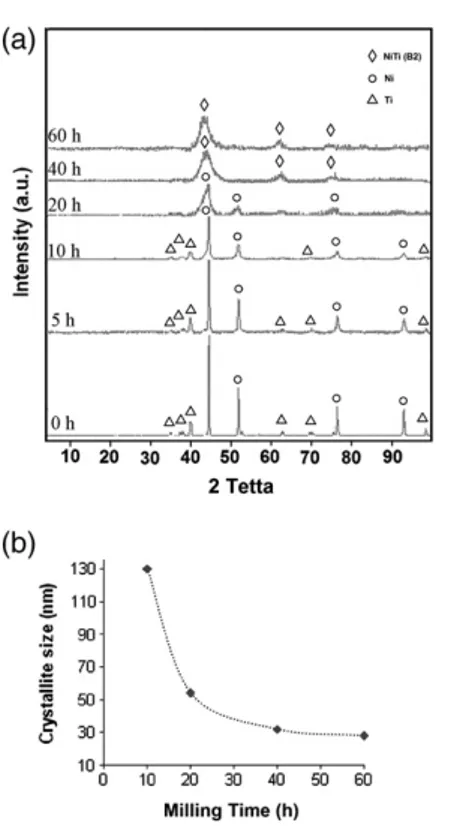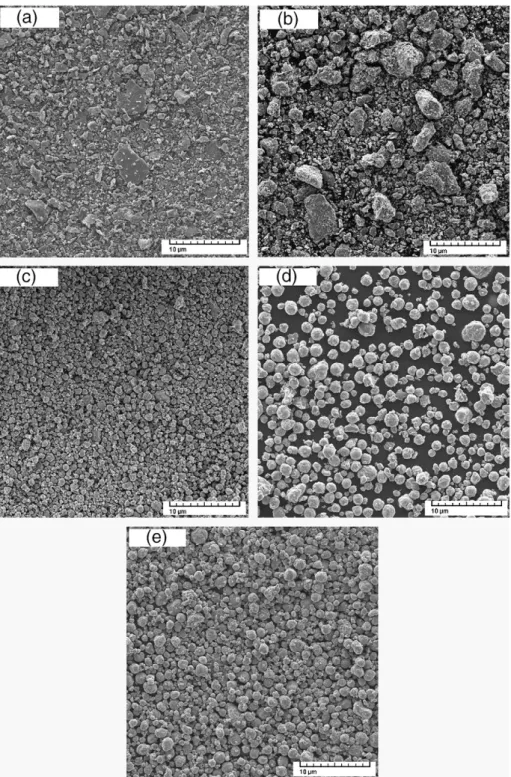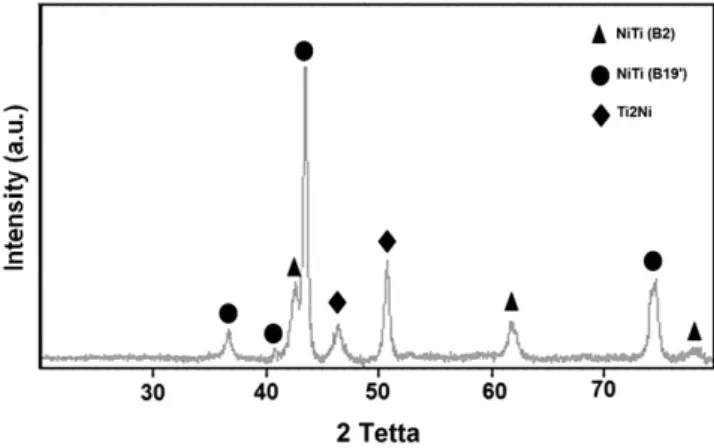Effects of milling and annealing on formation and structural characterization of
nanocrystalline intermetallic compounds from Ni
–Ti elemental powders
Morteza Ghadimi
a,⁎
, Ali Shokuhfar
a, Hamid Reza Rostami
b, Mohammad Ghaffari
ca
Advanced Materials and Nanotechnology Research Center, Faculty of Mechanical Engineering, K.N. Toosi University of Technology, P.O. Box: 19395-1999, Tehran, Iran
bFaculty of Materials Science and Engineering, Science & Research Branch, Islamic Azad University, P.O. Box: 14515-775, Tehran, Iran c
UNAM - Institute of Materials Science and Nanotechnology, Bilkent University, Ankara 06800, Turkey
a b s t r a c t
a r t i c l e i n f o
Article history: Received 2 March 2012 Accepted 22 April 2012 Available online 27 April 2012 Keywords:
Shape memory materials Nanocrystalline materials Intermetallic alloys and compounds Phase transformation
Electron microscopy X-ray techniques
Nickel and Titanium elemental powders with a nominal composition Ni–50 at.%Ti were mechanical alloyed in a planetary high-energy ball mill in different milling conditions (5, 10, 20, 40 and 60 h). The investigation revealed that increasing milling time leads to a reduction in crystallite size, and after 60 h of milling, the Ti dissolved in Ni lattice and NiTi (B2) phase was obtained. With milling time, morphology of pre-alloyed pow-ders changed from lamella to globular. Annealing of as-milled powpow-ders at 1173 K for 900 s led to formation of nanocrystalline NiTi (B19′), grain growth and release of internal strain. The results indicated that this tech-nique is a powerful and high productive process for preparing NiTi intermetallic compound with nanocrys-talline structure and appropriate morphology.
© 2012 Elsevier B.V. All rights reserved.
1. Introduction
NiTi shape memory compounds are being used in a variety of medical and engineering purposes owing to unique shape memory effect (SME) and superior superelasticity with excellent corrosion re-sistance, good biocompatibility and wear resistance. Shape memory behavior of this material is due to thermoelastic martensitic transfor-mation from high temperature B2 (austenite) to low temperature B19′ (martensite) phase[1–3]. Shape memory materials are made by well-known methods related to melting and casting. These ap-proaches are high energy consuming and imply difficulties in control of the processed alloy composition[1]. In order to obtain inexpensive products, researchers have been focused on nearly synthesis process in efforts to establish to optimum production route and to obtain ma-terials with improved properties.
Mechanical alloying (MA) is a versatile and widely used technique for preparation of intermetallic compounds, because of its advantages including high yield, low cost, and ease of control of particle size and shape. Moreover, in this process, the reduction of particle size to nano-scale results in nanocrystalline materials with homogeneous structures. In this method, high-energy collisions of the balls and the vial lead to repeated cold welding and fracturing of powders, andfinally preparation of alloyed powders[4–6].
Materials Letters 80 (2012) 181–183
⁎ Corresponding author. Tel.: +98 912 8040281; fax: +98 21 88677274. E-mail addresses:ghadimi1985@gmail.com,mghadimi@sina.kntu.ac.ir
(M. Ghadimi).
Fig. 1. (a) XRD patterns of mixture powders at several milling times and (b) Crystallite size of mixture powders as a functional of milling time.
0167-577X/$– see front matter © 2012 Elsevier B.V. All rights reserved. doi:10.1016/j.matlet.2012.04.098
Contents lists available atSciVerse ScienceDirect
Materials Letters
The present paper reports the synthesis and investigation of nano-crystalline intermetallic compounds in Ni–Ti system by MA and fur-ther heat treatment. Meanwhile, the effects of milling time and annealing process on grain size, morphological changes and phase compositions were studied.
2. Material and methods
The elemental powders of Ni (99.9% purity) and Ti (99.5% purity) with a mean particle size of about 10μm and nominal composition Ni–50 at.%Ti were mechanically alloyed in a planetary high energy ball mill (Fritch P6) using hardened stainless steel balls (50 balls with diameter of 10 mm) and vial (225 ml) in different milling times. A ball to powder weight ratio (BPR) of 10:1 was maintained
and milling speed was adjusted to 300 rpm. The milling was carried out under a protective argon atmosphere to avoid oxidation and at-mospheric contamination of powders.
After certain milling conditions (5, 10, 20, 40 and 60 h), a small amount of milled powder was collected for structural evaluation through XRD analysis with Xpert Philips diffractometer using a Fe fill-er and Cu Kα radiation (λ=0.15406 nm) at a voltage and electrical current of 40 kV and 30 mA, respectively. The evaluation of morphol-ogy and study of particle size were performed via scanning electron microscopy (SEM) at a voltage of 15 kV in a Vega© Tescan. After 60 h milling, the as-milled powders were sealed in quartz tubes under high vacuum and annealed at 1173 K for 900 s followed by water-quenching in order to study the phase transition occurring during annealing.
Fig. 2. SEM micrographs of milled powders after different milling times (a) 5 h; (b) 10 h; (c) 20 h; (d) 40 h and (e) 60 h.
3. Results and discussion 3.1. XRD analysis
XRD diffraction profiles of milled powders at various milling times are shown inFig. 1a. According to thisfigure, the peaks related to raw materials can be detected in starting materials. With milling time, there is broadening of the diffraction peaks and a significant decrease in the line intensity of all diffraction peaks. In addition, the position of the diffraction lines corresponding to Ni moved to lower angles. The weakening of Ni and Ti peaks and the shift of Ni peaks toward lower angles indicated that Ti atoms diffused into the Ni matrix and lattice parameters of Ni increased. The peaks related to Ti disappeared 20 h of milling. On the other hand, there was no evidence for exis-tence of Ti in mixture compounds. In fact, the Ti dissolved completely in the Ni lattice. After 60 h milling, the Ni peaks vanished completely and only broadened NiTi (B2) peaks with a body centered cubic struc-ture were identified. The broadening of the NiTi peaks was considered to be due to the refinement effect of crystallite size. The crystallite sizes of compounds were calculated using XRD peak broadening and Williamson–Hall formula as follows[6]:
ffiffiffiffiffiffiffiffiffiffiffiffiffiffiffiffiffiffiffi Bi2−B02 q
cosθ ¼ 0:89λ=d þ 2esinθ ð1Þ
where Biis the peak full-width at the half of the maximum intensity
of XRD patterns (FWHM), B0is the correction factor for instrument
broadening,θ is the Bragg angle, λ is the wavelength of the X-ray used, d is the crystallite size and e is the lattice strain.
Fig. 1b shows the variations of crystallite sizes versus milling time. Increasing of milling time led to reduction in crystallite size that is mainly due to severe deformation of powders during ball milling. The other reason might be increased probability of nucleation sites during crystallization, provided by higher defect densities[4]. At the onset of milling process, crystallite size decreased dramatically and lattice strain increased. However for longer milling times, grain size almost did not change and became constant due to the balance be-tween rate of cold welding and fracturing of powders particles[5]. After 60 h of milling, crystallite size of milled powders reduced down to 24 nm.
3.2. SEM observation
Fig. 2presents the morphology of milled powders after several milling time. At the beginning of milling, a lamellar structure was ob-served, because of continuous cold welding between laminate during ball milling of ductile particle has occurred, but the spaces between these lamellae are high. Increasing milling time to 10 h, the laminated structure becomes discontinuous and the thickness of the layers de-creases. On further milling, the size of particles decreases because, in-crease in brittleness leads to formation of smaller particles with granular shape. Meanwhile, the distribution of particle morphology and particle size becomes narrower. On the other hand, the repeated processes of cold welding and fracturing result in generation of ag-glomerations consisting of nanosized Ni and Ti particles.
3.3. Annealing
Fig. 3displays the XRD spectra of milled and annealed powders at 1173 K for 900 s. As can be seen the annealing process induced sever-al diffraction peaks and led to formation of NiTi (B19′ with a body monoclinic structure) and Ti2Ni phases. Since the annealing
tempera-ture was higher than 0.6 Tm(Tm: melting temperature of NiTi),
re-crystallization occurred and caused grain growth due to release of internal strains. The crystallite size increases from initial value to 59 nm.
4. Conclusions
(1) MA of pure elemental Ni and Ti powder mixtures in a planetary high-energy ball mill led to solution of Ti into B2 structure and preparation of NiTi intermetallic phase with nanocrystalline structure and homogeneous configuration.
(2) The annealing of as-milled powders resulted in production of nanostructured NiTi (B19′) phase.
(3) The XRD examinations and SEM observations revealed that the mechanical alloying fallowed by annealing is a useful, cost ef-fective and high productive method for preparing NiTi inter-metallic compounds with appropriate structures and suitable morphologies.
References
[1] Otsuka K, Ren X. Physical metallurgy of Ni–Ti-based shape memory alloys. Prog Mater Sci 2005;50:511–678.
[2] Da Silva EP. Calorimetric observations on an NiTi alloy exhibiting two-way memory effect. Mater Lett 1999;38:341–3.
[3] Ballas M, Li Z, Ilegbusi OJ. Modeling reaction front propagation and porosity in pressure-assisted combustion synthesis of porous NiTi Intermetallics. J Mater Eng Perform 2012;21:298–307.
[4] Suryanarayana C. Mechanical alloying and milling. New York: Marcel Dekke; 2004. [5] Ghaffari M, Tan PY, Oruc ME, Tan OK, Tse MS, Shannon M. Effect of ball milling on the characteristics of nano structure SrFeO3powder for photocatalytic degradation
of methylene blue under visible light irradiation and its reaction kinetics. Catalysis Today 2011;161:70–7.
[6] Nazanin-Samani M, Kamali AR, Mobarra R, Nazarian-Samani M. Phase transforma-tion of Ni–15 wt.% B powders during mechanical alloying and annealing. Mater Lett 2010;64:309–12.
Fig. 3. XRD patterns of powders after 60 h milling + 900 s annealing.
183 M. Ghadimi et al. / Materials Letters 80 (2012) 181–183


